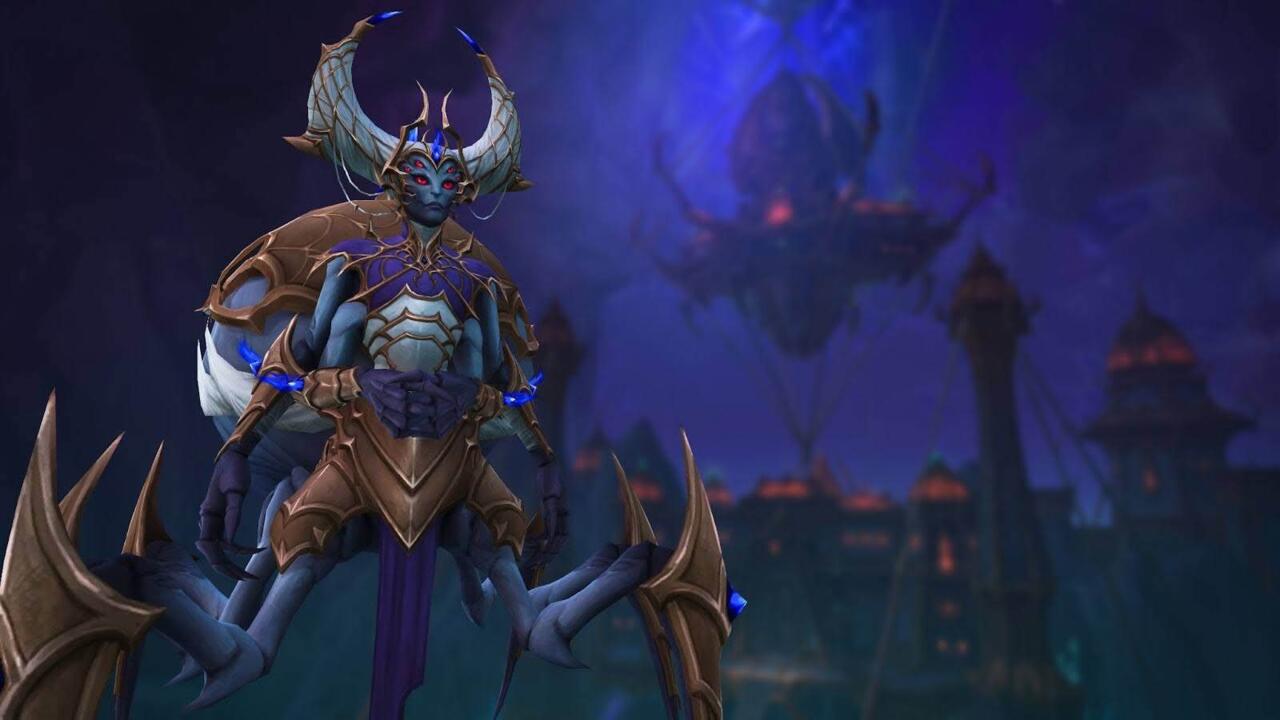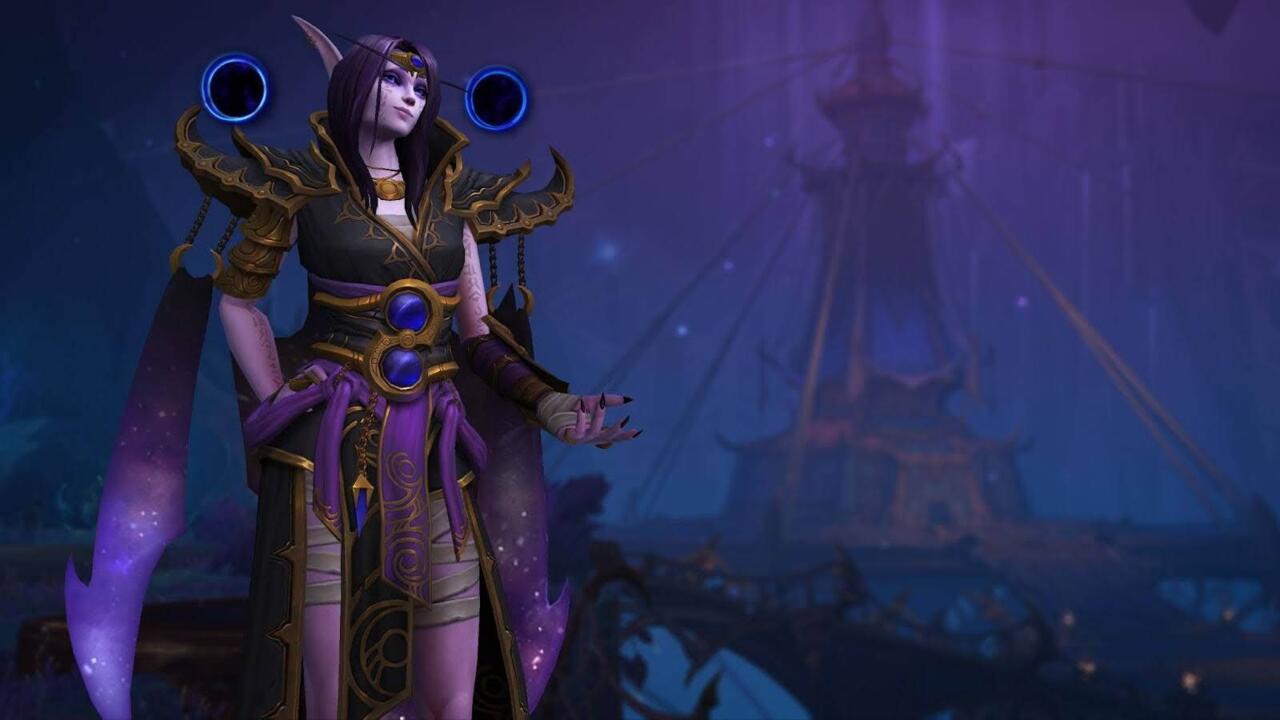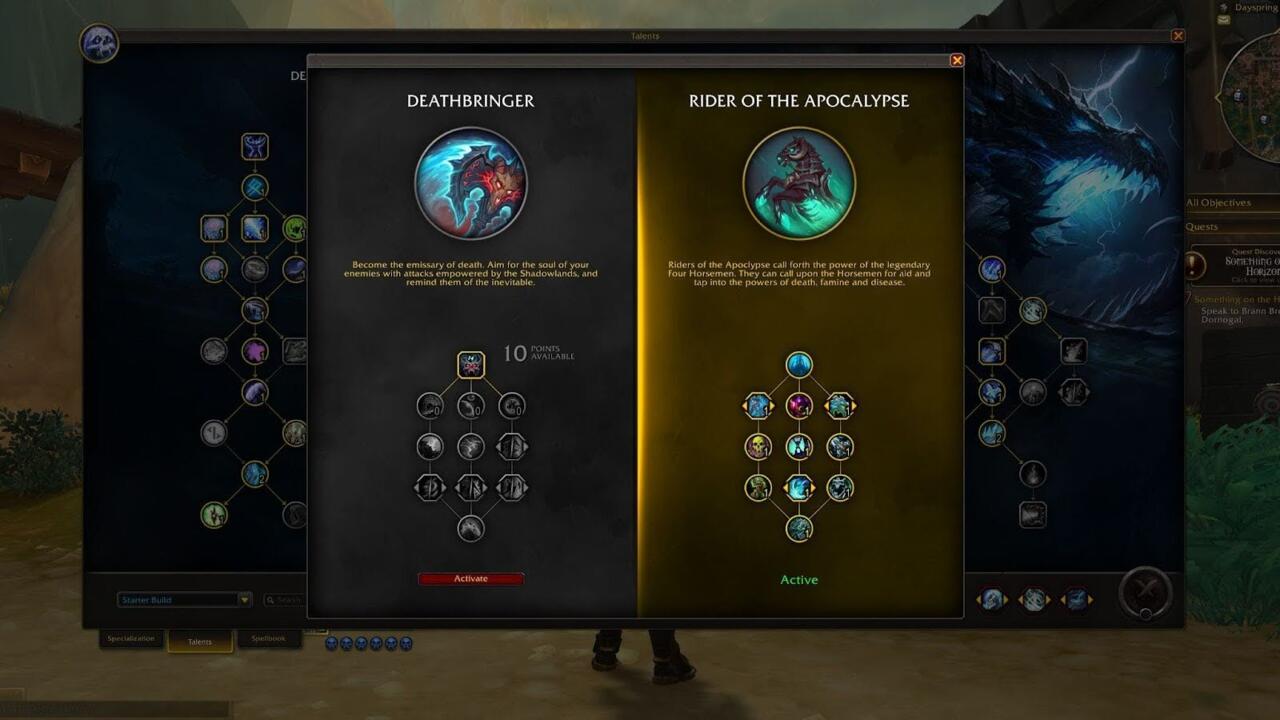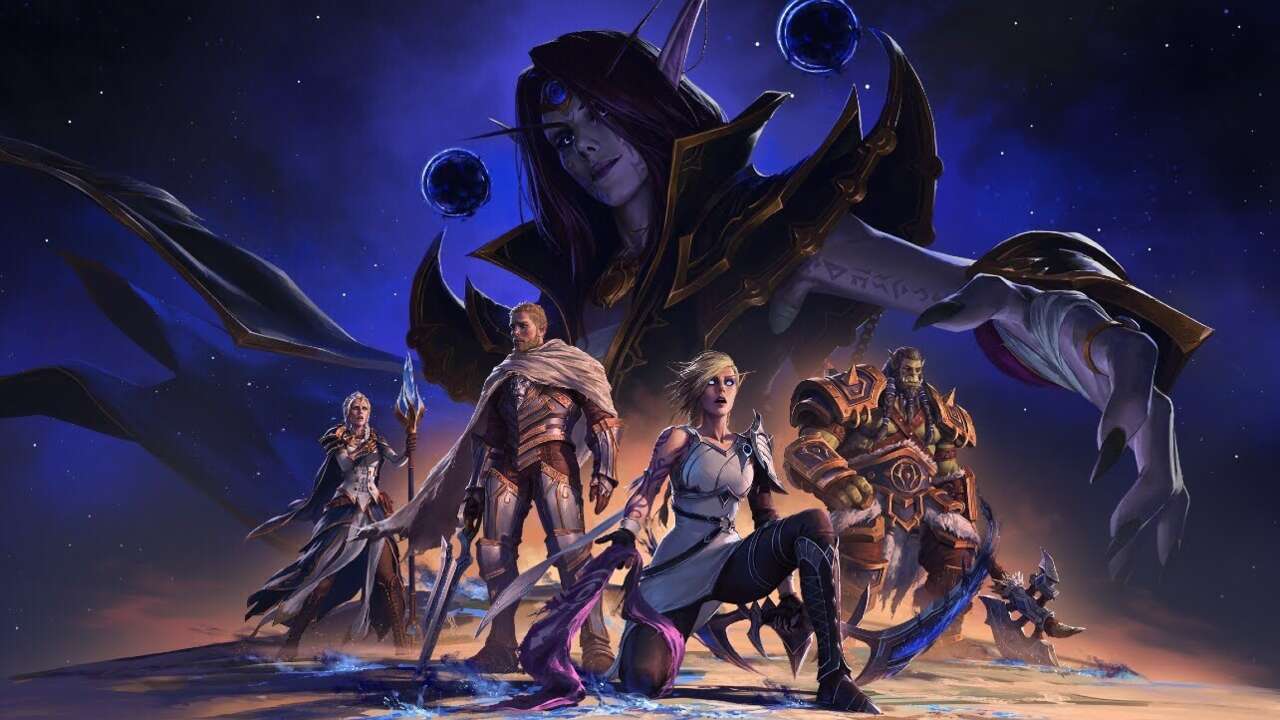World of Warcraft: The War Within makes a hell of a first impression. Within the expansion’s first 10 minutes, one of the Warcraft universe’s greatest heroes, the archmage Khadgar, is seemingly vaporized. Moments later, one of WoW’s most iconic cities, Dalaran, is obliterated. You wake up amidst the wreckage, search for survivors, fend off attacks from the spider-like Nerubians, and then set out on a journey deeper and deeper into Azeroth’s depths to find the one responsible for the carnage–WoW’s new big bad, Xal’atath.
It’s a bold opening for the 10th expansion in WoW’s two-decade history–one that almost reads as a signal to past and present WoW players that Blizzard is looking to up the narrative stakes as it moves forward. The War Within kicks off what is billed as the first part of a three-expansion storyline called the Worldsoul Saga, which will look to bring together many of the game’s core plotlines from over the years, as the MMO nears its 20th anniversary.
It’s only fitting then that The War Within builds brilliantly on what came before, not only from a story perspective but also in continuing many of the trends and design philosophies that helped make the game’s previous expansion, Dragonflight, the course-correction WoW desperately needed. The War Within realizes many of those ideas to something close to their full potential, giving the expansion a “been there, done that” feel at first that quickly subsides once it becomes clear just how dramatically those ideas, whether it’s account-wide progression or the ability to do endgame content entirely solo, change the way Blizzard’s MMORPG is played. While not every new feature is a home run, namely Hero Talents, The War Within is otherwise laser-focused in its execution of letting players play WoW the way they want to, and in that it overwhelmingly succeeds.
World Of Warbands
That’s no small feat. Like in Dragonflight, Blizzard opted to forgo one-off expansion features this time around and instead focus on recurring ones that will be WoW staples for the foreseeable future. The biggest this time around is Warbands, a bit of a catch-all feature that encompasses and fully fleshes out many of the baby-step account-wide progression features Blizzard previously rolled out, both in Dragonflight and in expansions prior. Now, nearly everything is shared across a player’s account rather than limited to a specific character. Items, some gear, and currencies can easily be transferred between characters on the same account. Renown and reputation gains, long one of the most frustrating parts of making and progressing a new character, are now shared across all characters on an account. Many aspects of the game that were already somewhat account-wide, like achievements and a player’s transmog collection, have been expanded even further here, with players now able to earn weapon and armor appearances regardless of if their current character can use those items.
It’s hard to overstate how much of a game-changer this is. For the first time in my long history of playing WoW, I began to level up an alternate character immediately after completing the story campaign on my main. While playing my alt, quests already completed by my main can be conveniently hidden on the map, letting me better hone in on other side quests I skipped initially. All of the achievement progress, quest-reward gear appearances, upgrade currencies, and Renown earned from doing these side quests are account-wide, meaning that even though I’m leveling a completely different character, my main character is still benefiting. Even if it feels long overdue, now that it’s finally here, it’s hard to fathom how WoW players endured 20 years of character-locked progression.
Journey To The Center Of Azeroth
The changes Warbands bring make just about any progress meaningful progress. That progress, in turn, makes seeking out all of the sights and sounds of The War Within’s new Khaz Algar region even more rewarding than it would be otherwise. Home of the new playable race, the Earthen, Khaz Algar is a series of four zones. The one players find themselves in following Dalaran’s destruction, the Isle of Dorn, is on Azeroth’s surface: a lush, green biome filled with familiar dwarven architecture. A massive underground tunnel, the Coreway, connects it to the game’s next zone, the mines of the Ringing Deeps. That zone, in turn, is connected to two other zones: Hallowfall and the Nerubian kingdom of Azj-Kahet.
WoW zones within an expansion have always largely been traversable without loading screens, but there is something extremely satisfying about being able to hop on your flying mount (which can now be controlled in the same way as Dragonflight’s dragonriding mounts), leap from the Earthen city of Dornogal, nosedive into the Coreway, and find yourself in a vast, subterranean world, all without interruption. This might be the best collection of zones ever introduced in a WoW expansion. Each one stands tall in its own way, with varied scenery, zone-specific events, and interesting storylines, but two stand out to me in particular: Azj-Kahet and Hallowfall.

Azj-Kahet in many ways feels like an updated version of Suramar from 2016’s Legion expansion, as players work with a Nerubian resistance group to overthrow an evil queen. Like Suramar, there is even a sprawling city, the City of Threads, to explore–filled with quests, patrolling guards, and a corresponding dungeon that is an instanced version of the city. It definitely feels familiar, but given that slowly progressing through Suramar to wrench the city from the clutches of its corrupted ruler in Legion’s endgame was one of that expansion’s highlights, I’m happy to see the formula repeated here. While Azj-Kahet is largely focused on the Nerubians, there is also a mysterious new race–the dark troll-like Haranir–that exists in the shadows of the zone. Despite one appearing in a cinematic trailer, they are a relatively small presence in the game at launch, and I’m curious to see what role the Haranir play in the months ahead.
Entering the massive cavern of Hallowfall for the first time as part of the main campaign almost feels like stepping into an entirely new expansion, evoking a feeling similar to emerging from the sewers of the Imperial City and venturing into Cyrodiil at the start of The Elder Scrolls IV: Oblivion or stepping into Hyrule for the first time in The Legend of Zelda: Breath of the Wild. Blizzard’s art team has truly outdone itself here: Airships dot the skies, and a massive light-emitting crystal makes the zone appear not as if it was deep underground but on the surface. When that crystal transforms in real time from emitting holy energy to being shrouded in the darkness of the void, the zone takes on an entirely different feeling. Hallowfall is home to the Arathi Expedition, an offshoot of a long-hidden empire. Though the dwarf-like Earthen are billed as the game’s newest culture and playable race, it’s the Arathi, many of whom are half-elves, who steal the show. I found myself hooked on learning more about them, their culture, and the mysterious empire from which they hail.
That’s not to say the Earthen aren’t full of their own surprises. If I’m being honest, I wasn’t very excited about the rock-dwarves when they were first revealed. They’ve been glimpsed in WoW before and nothing about them initially made me eager to learn more, much less create an Earthen character. I’m happy to report that they are far more interesting than they appear to be at first glance: a culture divided into those who still serve their Titan creators and those who seek their own path. Due to their almost mechanical nature and long-lasting lives, many Earthen storylines revolve around memory, as the Earthen are periodically reborn and their memories essentially overwritten. Some reject this fate and opt to die a natural death of sorts, while others are forced to come to terms with essentially starting life over. One of the expansion’s most touching, and potentially tear-jerking, questlines revolves around an elderly Earthen losing their memory and preparing for the end of their life. They enlist you to help them make one final journey, and along the way you watch their mind and memory fade, and the effect it has both on them and their caregiver. It’s an emotional quest, especially for those who have found themselves having to watch a loved one go through a similar experience, as I and many others have. Blizzard handles it with a deft hand, and it will be a story I remember for a long, long time.
For The Alliance
Story is one of The War Within’s strong suits. Whereas Dragonflight was a welcome reprieve from the game’s much-hated Shadowlands expansion (with its convoluted lore revolving around afterlives, Arbiters, and whatever the Jailer’s deal was), Dragonflight also felt largely inconsequential and disconnected from WoW’s larger narrative and many of its most prominent characters. That’s not the case with The War Within, which immediately takes a major player off the board and establishes Xal’atath, shrugging off an arcane kamehameha with hardly a scratch like she’s a Dragon Ball Z villain. Xal’atath has come a long way from her origins as a talking knife in Legion, and even if her ability to seemingly be invulnerable is a little one-note so far, she is scary and ruthless in a way a Warcraft villain hasn’t been since the likes of Garrosh. I’m excited to see how every WoW player’s favorite “knaifu” develops over the course of The Worldsoul Saga, it having been confirmed she won’t be a “one and done” expansion villain.
Whereas many of WoW’s most-important characters were, for the most part, MIA in Dragonflight’s campaign, they take center stage here, though Horde players are likely to be disappointed. Much of The War Within focuses on Alleria Windrunner, Magni Bronzebeard, and Anduin Wrynn, who are each struggling with their own internal demons in the face of yet another crisis on Azeroth. They are all Alliance characters, leaving the former Horde warchief Thrall, who is only present in the main story’s opening moments before leaving to gather reinforcements, as the only Horde representation. I won’t spoil much, but excluding Thrall (and Jaina Proudmoore, who also appears briefly at the start), each character undergoes a personal journey and comes out the other side with a new perspective. It’s not exactly groundbreaking stuff, but it is nice to see the story of someone like Magni, who has been stuck in character-development hell for over half a decade as Azeroth’s Speaker, move forward in a meaningful way. It’s just a shame Blizzard couldn’t find a Horde character to put a spotlight on over the course of the main story, though post-campaign story quests have already put more of a focus on Thrall and other Horde characters than the campaign itself does.

How Blizzard’s latest tells its story is also worth mentioning, as it’s a serious step up even from Dragonflight. The main story itself is relatively short but moves at a steady pace as players progress through each zone in a linear fashion, sprinkled with far more in-engine cutscenes than in previous expansions. Each cutscene demonstrates just how far Blizzard’s storytelling has come in recent years, with greatly improved character models and animations. The main story even takes players directly through modified versions of some of the game’s dungeons thanks to the recent addition of NPC Follower dungeons–a first for a WoW expansion and a move that makes the game’s overarching story and that of many of its dungeons feel more interwoven than in previous expansions. On subsequent characters, players can play the campaign in any order, or just ignore it and focus on side quests and world quests. Players will need to supplement the game’s campaign quests with side quests and content in order to reach max level on their first character, and that’s where many of The War Within’s best narrative moments can be found.
Many NPCs now include additional dialogue options lore-hungry players can use to learn more about Khaz Algar’s people and their cultures. Some of my favorite (and completely optional) quests simply involve sitting at a table talking with various characters, whether it’s chatting with Anduin and Faerin Lothar while learning an Arathi board game or joining in on an Arathi family dinner. In addition, many NPCs in main quests and prominent side-quest chains feature a “Stay awhile and listen” option that, when selected, plays out an extra, extended dialogue scene between characters. This option isn’t strictly new for this expansion, but it is used far more frequently, and to much greater effect, than the handful of times it’s appeared in the past. Though they are entirely optional, these dialogue scenes deliver some of The War Within’s most-memorable beats, like Magni bonding with his grandson Dagran or Alleria being reunited with her partner. Rather than simply speeding through quests as quickly as possible (as I have been guilty of doing in the past), I found myself clicking every dialogue option and always opting to “stay awhile,” which helped me become even more invested in the game’s cast of characters and its new setting.
Delving Into Endgame
Beyond improvements to storytelling, Blizzard has clearly recognized that there is a sizable number of WoW players who aren’t into pushing Mythic dungeon keys or raiding with a group of 20 strangers in order to gear up and progress through WoW’s endgame–a formula that has largely stayed the same since 2016’s Legion expansion. Enter Delves: a new form of endgame content that can be done entirely solo (or with a group).
It’s too early to say how Delves will pan out long-term given that only three out of 11 total difficulty options are currently available, but so far they are largely a good time. Each of the game’s 12 Delves at launch sees players battling their way through a 10-15-minute scenario with varied objectives and modifiers, whether it’s rescuing trapped miners or finding specific items. Some of the Delve-specific mechanics are more enjoyable than others. One somewhat annoying underwater Delve requires players to seek out air bubbles lest they drown, while another tasks players with avoiding spider-webs on the ground that, when stepped on, will summon more enemies. There are variants of each Delve too, and each culminates in a boss fight, after which there is a treasure room of rewards for players to collect. Defeating rare mobs inside a Delve will reward players with a temporary power similar to the ones seen in Torghast or occasionally used in various activities in Dragonflight, giving players an additional edge that I’m sure will be more necessary at higher difficulties. Within a Delve, players are accompanied by an NPC companion who will change seasonally. At launch, it’s dwarven explorer Brann Bronzebeard, who can be assigned a healer or damage-dealing role and customized with various abilities.
Delves aren’t as inventive or visually exciting as the game’s tried-and-true dungeons, of which there are some true standouts this time around, like one that sees players darting from various airships to repel a Nerubian attack or another set in a massive cathedral that brings to mind the game’s old Scarlet Monastery dungeons. Delves are, however, extremely easy at lower difficulties, though I’m sure that’s something that will change once the higher tiers are unlocked. As an endgame activity for largely solo players to gear up and earn rewards, it seems like they will get the job done and accomplish their goal of being bite-sized adventures players can squeeze in when short on time while still offering meaningful rewards.
Talent Show
If there is one new addition in The War Within that doesn’t quite land, it’s Hero Talents. These sub-specializations (two for each spec) aim to bring even more power to players while delivering on some of Warcraft’s long-established fantasies, whether it’s becoming a Dark Ranger Hunter or a Rider of the Apocalypse Deathknight. Each Hero Talent tree features 10 nodes, all of which players will have unlocked at the new max level of 80. In each tree are a handful of nodes that give players the option to select between two choices.
While often visually impressive (I will never get tired of seeing a Pit Lord stick its head out of the Twisting Nether to blast my foes as a Diabolist Warlock), from a gameplay perspective Hero Talents leave plenty to be desired. Players have very few choices to make within the trees themselves, and each tree largely consists of passive skills that modify existing abilities. Of the Hero Talents I’ve been able to use and look through, it appears the majority of Hero Talent trees don’t alter the way you play your character in any significant way. That’s certainly true in the case of the four Hero Talent trees I tried as a Retribution Paladin and Demonology Warlock.

Balance is also an issue, as it seems like many Hero Talent specs are simply better than the alternative for any given specialization. That was the case for Retribution and Demonology, where the strong visuals and power that came from the Templar and Diabolist Hero Talents far outshined the respective alternative options, Herald of the Sun and Soul Harvester. That makes for an unpleasant scenario where a player may really like the particular class fantasy of one Hero Talent specialization but feel forced to pick a different one in order to be competitive in endgame activities. Damage numbers and the like can be tuned in the weeks ahead to make lacking Hero Talent specs more competitive, but it still seems like a misfire in an expansion that is otherwise on-point.
As for the rest of The War Within, PvP players are finally thrown a bone in the form of a new PvP battleground, Deephaul Ravine. It’s the first new battleground introduced since 2018, and one that is most similar to Mists of Pandaria’s Silvershard Mines. Two teams battle to escort two carts to their destination in order to score points, while the team that captures the crystal (aka flag) found in the middle of the symmetrical map will earn points as well. Having played a few rounds of the new battleground, I’m impressed by its simplicity. The map itself is small, meaning players are almost constantly in the action. However, the map does feature more verticality than most WoW battlegrounds, with players able to battle it out atop (or shoot down from) an elevated minecart rail that cuts through the center of the map. That adds an extra bit of strategy, as it’s on top of the bridge where abilities that can displace enemies truly shine, allowing you to knock foes down to the ground below, causing them to take fall damage.
With some truly impressive new zones, top-notch presentation in both art direction and music, a renewed emphasis on storytelling and characters, a whole new form of endgame content in Delves, full-fledged account-wide progression, and even a new PvP battleground for the first time in six years, The War Within is the complete WoW package. Though it may be lacking in a big, expansion-specific feature, the evergreen features it does add change the game dramatically for the better. Even if Hero Talents, both in concept and execution, don’t quite stick the landing, many of them do at least look extremely cool, which isn’t nothing in a game where the true endgame for many players is to look as stylish as possible. The fact that they are intended to be a core part of the game going forward means Blizzard will have time to get balancing right and hopefully up the, ahem, “wow factor” of underwhelming Hero Talent specs, but it is a shame that they don’t make a bigger splash right out of the gate.
The War Within marks not only the start of The Worldsoul Saga, but the beginning of what seems like a new era of WoW. All the old staples–Mythic+ dungeons, raids, PvP, world quests– are still there, but the game’s newfound focus on letting you play how you want to play, rather than forcing you to play a certain way, makes it a far more enjoyable experience. Blizzard is finally meeting players where they are, not where it wants them to be, and that means whether you like to focus on one character or play many–solo or with a guild–there is something here for you. The War Within is WoW at its most approachable, and it’s all the better for it.
